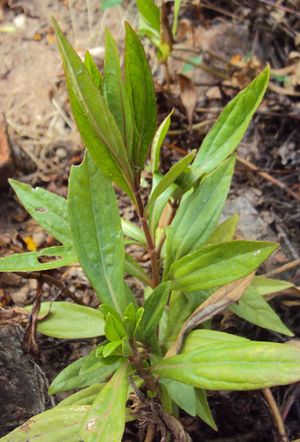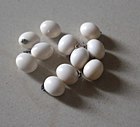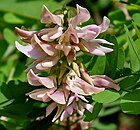Note: This is a project under development. The articles on this wiki are just being initiated and broadly incomplete. You can Help creating new pages.
Difference between revisions of "Ayapana triplinervis - Vishalyakarni"
m (Prabhakar moved page Vishalyakarni (Eupatorium triplinerve) to Eupatorium triplinerve - Vishalyakarni) |
|||
| Line 1: | Line 1: | ||
| + | {{stub}} | ||
| + | |||
[[File:Eupatorium triplinerve.jpg|thumb|right|''vishalyakarni'', ''Eupatorium triplinerve'']] | [[File:Eupatorium triplinerve.jpg|thumb|right|''vishalyakarni'', ''Eupatorium triplinerve'']] | ||
| − | Ayapana triplinervis | + | Ayapana triplinervis is a tropical American shrub in the Asteraceae family. This plant has long slender leaves which are often used to make a stimulating medicine. The herb is stimulant, tonic in small doeses and laxative when taken in quantity. |
| + | |||
| + | ==Uses== | ||
| + | {{Uses|piles}}, {{Uses|poisoning}}, {{Uses|skin diseases}}, {{Uses|nausea}}, {{Uses|vomiting}}, {{Uses|colitis}}, {{Uses|chronic fevers}}, {{Uses|enlarged abdomen}}, {{Uses|jaundice}} | ||
| + | |||
| + | ==Parts Used== | ||
| + | {{Parts Used|Leaves}}, {{Parts Used|stem}} | ||
| + | |||
| + | ==Chemical Composition== | ||
| + | The coumarins, ayapanin and ayapin, stigmasterol, esculetin methylene ether, vitamin C and carotene<ref name="chemical composition"/> | ||
| + | |||
| + | ==Common names== | ||
| + | {{Common names|kn=|ml=Aiyappana, Mrithasanjeevani|sa=Vishalyakarni, Ayaparnah|ta=Ayappani|te=Gurivinda or Guriginja|hi=Ayapan, Ayaparna|en=Ayapana tea}} | ||
| + | |||
| + | ==Properties== | ||
| + | Reference: Dravya - Substance, Rasa - Taste, Guna - Qualities, Veerya - Potency, Vipaka - Post-digesion effect, Karma - Pharmacological activity, Prabhava - Therepeutics. | ||
| + | ===Dravya=== | ||
| + | ===Rasa=== | ||
| + | Tikta (Bitter), Kashaya (Astringent) | ||
| + | ===Guna=== | ||
| + | Laghu (Light), Ruksha (Dry) | ||
| + | ===Veerya=== | ||
| + | Ushna (Hot) | ||
| + | ===Vipaka=== | ||
| + | Katu (Pungent) | ||
| + | ===Karma=== | ||
| + | Pitta | ||
| + | ===Prabhava=== | ||
| + | |||
| + | ==Habit== | ||
| + | {{Habit|Sub shrub}} | ||
| + | |||
| + | ==Identification== | ||
| + | ===Leaf=== | ||
| + | {{Leaf|opposite|smooth|opposite, narrowly elliptic or lanceolate and 5 to 8 centimeters long}}<ref name="Leaf"/> | ||
| + | |||
| + | ===Flower=== | ||
| + | {{Flower|Unisexual|6 to 13 millimeters|pink|bearing about 20 pink flowers|Pappus is about 3 millimeters long}} | ||
| + | |||
| + | ===Fruit=== | ||
| + | {{Fruit|Fruit are achenes|Thinly septate, pilose, wrinkled||seeds upto 5|Fruiting throughout the year}} | ||
| + | |||
| + | ===Other features=== | ||
| + | |||
| + | ==List of Ayurvedic medicine in which the herb is used== | ||
| + | * [[Vishatinduka Taila]] as ''root juice extract'' | ||
| + | |||
| + | ==Where to get the saplings== | ||
| + | |||
| + | ==Mode of Propagation== | ||
| + | {{Propagation|Seeds}}, {{Propagation|Cuttings}} | ||
| + | |||
| + | ==How to plant/cultivate== | ||
| + | The more common species of Aconitum are generally those cultivated in gardens, especially hybrids. They typically thrive in well-drained evenly moist garden soils like the related hellebores and delphiniums, and can grow in the shade of trees. | ||
| − | + | ==Commonly seen growing in areas== | |
| + | {{Commonly seen|tropical}}, {{Commonly seen|Secondary forest}}, {{Commonly seen|moist locations}} | ||
| − | == | + | ==Photo Gallery== |
| + | <gallery class="left" caption="" widths="140px" heights="140px"> | ||
| + | File:AbrusWhiteSeeds.jpg|White variety of seeds. | ||
| + | File:Abrus precatorius W IMG 1578.jpg|''Abrus precatorius'' leaves and flowers | ||
| + | File:Abrus precatorius W2 IMG 1578.jpg|''Abrus precatorius'' flowers | ||
| + | File:IndianLicorice 7899.JPG|''Abrus precatorius'' seeds | ||
| + | File:Abrus_precatorius_%E2%80%94_Scott_Zona_001.jpg | ||
| + | </gallery> | ||
| − | + | ==References== | |
| − | |||
| − | + | <references> | |
| − | + | <ref name="chemical composition">[https://easyayurveda.com/2016/11/10/ayapana-eupatorium-triplinervis/ "chemical constituents"]</ref> | |
| − | <references> | + | <ref name="Leaf">[https://indiabiodiversity.org/species/show/265395 "morphology"]</ref> |
| − | <ref name=" | ||
</references> | </references> | ||
| − | == External Links == | + | ==External Links== |
| − | + | * [http://www.planetayurveda.com/library/ayapan-eupatorium-triplinerve Eupatorium triplinerve on planet ayueveda] | |
| − | *[https:// | + | * [https://www.bimbima.com/ayurveda/ayapana-eupatorium-triplinerve-herb-information-and-medicinal-uses/327/ Ayapana (Eupatorium triplinerve) Herb Information and Medicinal Uses] |
| + | * [http://ayapana.blogspot.in/ EUPATORIUM TRIPLINERVE-charecteristics] | ||
| + | * [http://tropical.theferns.info/viewtropical.php?id=Ayapana+triplinervis triplinervis on useful trophical plants] | ||
[[Category:Herbs]] | [[Category:Herbs]] | ||
Revision as of 11:42, 8 May 2018
Ayapana triplinervis is a tropical American shrub in the Asteraceae family. This plant has long slender leaves which are often used to make a stimulating medicine. The herb is stimulant, tonic in small doeses and laxative when taken in quantity.
Contents
- 1 Uses
- 2 Parts Used
- 3 Chemical Composition
- 4 Common names
- 5 Properties
- 6 Habit
- 7 Identification
- 8 List of Ayurvedic medicine in which the herb is used
- 9 Where to get the saplings
- 10 Mode of Propagation
- 11 How to plant/cultivate
- 12 Commonly seen growing in areas
- 13 Photo Gallery
- 14 References
- 15 External Links
Uses
piles, poisoning, skin diseases, nausea, vomiting, colitis, chronic fevers, enlarged abdomen, jaundice
Parts Used
Chemical Composition
The coumarins, ayapanin and ayapin, stigmasterol, esculetin methylene ether, vitamin C and carotene[1]
Common names
| Language | Common name |
|---|---|
| Kannada | |
| Hindi | Ayapan, Ayaparna |
| Malayalam | Aiyappana, Mrithasanjeevani |
| Tamil | Ayappani |
| Telugu | Gurivinda or Guriginja |
| Marathi | NA |
| Gujarathi | NA |
| Punjabi | NA |
| Kashmiri | NA |
| Sanskrit | Vishalyakarni, Ayaparnah |
| English | Ayapana tea |
Properties
Reference: Dravya - Substance, Rasa - Taste, Guna - Qualities, Veerya - Potency, Vipaka - Post-digesion effect, Karma - Pharmacological activity, Prabhava - Therepeutics.
Dravya
Rasa
Tikta (Bitter), Kashaya (Astringent)
Guna
Laghu (Light), Ruksha (Dry)
Veerya
Ushna (Hot)
Vipaka
Katu (Pungent)
Karma
Pitta
Prabhava
Habit
Identification
Leaf
| Kind | Shape | Feature |
|---|---|---|
| opposite | smooth | opposite, narrowly elliptic or lanceolate and 5 to 8 centimeters long |
Flower
| Type | Size | Color and composition | Stamen | More information |
|---|---|---|---|---|
| Unisexual | 6 to 13 millimeters | pink | bearing about 20 pink flowers | Pappus is about 3 millimeters long |
Fruit
| Type | Size | Mass | Appearance | Seeds | More information |
|---|---|---|---|---|---|
| Fruit are achenes | Thinly septate, pilose, wrinkled | seeds upto 5 | Fruiting throughout the year | {{{6}}} |
Other features
List of Ayurvedic medicine in which the herb is used
- Vishatinduka Taila as root juice extract
Where to get the saplings
Mode of Propagation
How to plant/cultivate
The more common species of Aconitum are generally those cultivated in gardens, especially hybrids. They typically thrive in well-drained evenly moist garden soils like the related hellebores and delphiniums, and can grow in the shade of trees.
Commonly seen growing in areas
tropical, Secondary forest, moist locations
Photo Gallery
References
External Links
- Pages that are stubs
- Ayurvedic Herbs known to be helpful to treat piles
- Ayurvedic Herbs known to be helpful to treat poisoning
- Ayurvedic Herbs known to be helpful to treat skin diseases
- Ayurvedic Herbs known to be helpful to treat nausea
- Ayurvedic Herbs known to be helpful to treat vomiting
- Ayurvedic Herbs known to be helpful to treat colitis
- Ayurvedic Herbs known to be helpful to treat chronic fevers
- Ayurvedic Herbs known to be helpful to treat enlarged abdomen
- Ayurvedic Herbs known to be helpful to treat jaundice
- Herbs with Leaves used in medicine
- Herbs with stem used in medicine
- Herbs with common name in Hindi
- Herbs with common name in Malayalam
- Herbs with common name in Tamil
- Herbs with common name in Telugu
- Herbs with common name in Sanskrit
- Herbs with common name in English
- Habit - Sub shrub
- Index of Plants which can be propagated by Seeds
- Index of Plants which can be propagated by Cuttings
- Herbs that are commonly seen in the region of tropical
- Herbs that are commonly seen in the region of Secondary forest
- Herbs that are commonly seen in the region of moist locations
- Herbs





